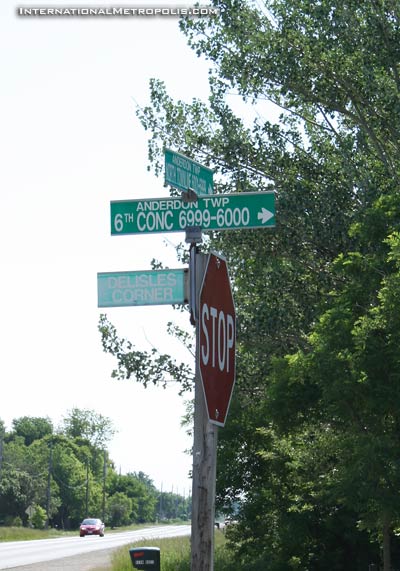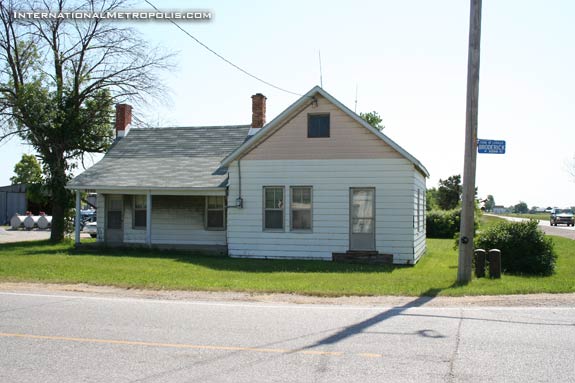Do you ever look at a map of Essex County and wonder what the heck all those little dots with strange names are? All kinds of phantom towns or villages are listed on the maps, new and old. So off we went in the hopes of finding some of lost Essex County.
The first target was Lukerville, or as it shows on some maps, Delisles Corners.

Map from 1959 showing Lukerville

More recent incarnation showing Delisles Corners

The old faded sign refers to Delisles Corners, but then again it shows Anderton Township, which hasn’t existed in about a decade. Google returns hits for Lukerville, showing Ministry of the Environment tests results, etc… One Genealogical website refers to Lukerville as a “Dispersed Rural Community”. Anyone out there know exactly what that means? The 1911 Ontario Census, returns results for Lukerville Village. The archives of Ontario has this helpful page: http://www.archives.gov.on.ca/English/guides/rg_209_municipal_records.htm.
Many places in Ontario were never incorporated as municipalities but included a post office or railway station. These places often are known by locally-recognized names. When trying to locate a hamlet, dispersed rural community or other small centre, consult the Gazetteer of Ontario.
It also sums up villages as the following:
Villages
Like cities and towns, villages are incorporated when a community within a township reaches a certain population density that justifies the creation of a separate administrative structure. Villages are governed by elected councils consisting of a Reeve, Deputy Reeves and a number of councillors based on the population of the village. A village is part of the county administration but not part of the surrounding township.

A view of downtown Lukerville.

Looking west. The large brown building is Western Secondary School.



Most of the houses of what was Lukerville are very old.

This old building sits on the s.w. corner of Lukerville, it is now some kind of Metalworking shop, but the building is from the early part of the last century.
Not sure what the history is of Lukerville, and why it’s basically vanished and ceased to be a village. If anyone out there knows anything, or has any stories, I’d love to hear them.

Andrew, I think the term “dispersed rural community” can be taken quite literally, as a community of widely spread residents with no “core” area. In places like Harrow, you have a well-defined center of town, whereas perhaps Lukerville was nothing more than a rural area with nothing more than a railway station to justify giving it a name of any kind at all.
D’oh! I think you’re right John… I was thiking dispersed, along the lines of sent away…
Years ago, there was a small blue sign (like a shrunken version of the typical provincial town name signs) that marked Delisles Corners on the 6th. For some reason, as I kid I thought it referred to the type of intersection (with Paquette Corners further east on North Townline as another type)!
Nice post; I’ve had an old map of Essex County since a kid and wondered about places like Delisle’s Corners, Strangefield & Mount Carmel. The map even has a font for smaller places – Klondyke, Elford, Windfall, &c.
Im curious as to what all would’ve gone on at Paquette corners. It looks like the Paquette corners of today is walker and townline, but not so in the map. Was Paquette Station a real hub activity? with and actual station house?
A: alot of those places are actually still listed on maps produced even today….. for example… The Meadows is listed as a similar place now we all know it as a bar/restauraunt….. but your right, windfal, elford, salem…….lots and lots of named communities and if you look real hard in some of these areas you will find reminence of these places if not actually marked signs such as the one in Delisle Corner’s…..
These names are sort of like ghosts, listed on maps. The trace endures.
Sammy, it’s actually amazing where I see these names pop up. Frequently, an Mapquest, for starters. Also, on my Mappoint topo mapsets there are tonnes of lost/vanished villages still acknowledged, which is very handy. I’m not sure if it’s just the cartographers not updating Essex county’s data or what, but I like it…
In the 60’s and 70’s the metalworking shop that you pic’d was “Kearns Aluminum and Bronze Foundry” run by Bob Kearns, a very talkative and opinionated gentleman, who I assume succumbed to some disease from all of the fumes .He also cast some lead mostly ornamental type stuff.. Not sure what it was when it first was built, but I think it has always been a Foundry. This is from back when you worked like a man and didn’t think about wearing something stupid like Respiration equipment, how could you smoke cigarettes and wear sissy stuff to protect yourself.
Absolutley…I have a few really good books on Ghost Towns and Ghost Railways of ontario with maprs, directions wheat to find everything!!! leaving these places on general use maps sure helps!
Sammy…….. Ron Brown fan? 😉
My dad used to take us for Sunday drives in the late ’50s in the area of “Lukerville”. He said that it was a tiny village that was named after one of his ancesters. Do you have a history of the place?
S.E. Paré:
http://internationalmetropolis.com/?p=401
Sorry it links right back to this article. I thought for a minute it was an earlier one. Sorry about that, S.E. Paré! I’ve googled this community name and sure can’t find anything substantial on the internet about it, save for this site. All but forgotten. This may warrant a trip to the WPL and a browse through the local history room. They have some interesting titles there that may help you with your ancestors place in Lukerville.
I remember when i was in my 20’s i drove a delivery truck for Beaver Lumber when they had their store on Walker rd,and i recall making a delivery to a house right by the tracks on town line rd i think they were dog breeders i recall seeing an old wooden structure on the east side of the track about the size of a 1 car garage it sat about 100 yards south of the grade crossing this could have been a station or section house maybe
The house in the first and third pictures is very old. I am almost certain that it dates to the late 1840s, and is of log construction. The back part where the porch is was a later addition, so if you just look at the front part, it has a distinct “log cabin” look. Their are still a few homes like this one left in old Anderdon, but they are tough to find. I just hope it never gets torn down, i’m sure it has alot of history to tell!
there was an area of the old c&o railroad between mcgregor and the last level grade crossing befor the train arrived in Harrow it was known as the Marshfield curve could marshfield possibly be another one of those old rural hamlets like Lukerville???
The Border Cities Star on Dec 31 1931 mentions a public meeting in a blacksmith’s shop in Lukerville owned by a Mr Dupuis. Likely this is the foundry building
.http://news.google.com/newspapers?id=PNNEAAAAIBAJ&sjid=ULoMAAAAIBAJ&pg=5116,3381295&dq=lukerville&hl=en
Gary, I don’t know whether Marshfield was a hamlet to any extent or just the marshy geographic area that Hiram Walker attempted to establish a cranberry patch in the late 1800s.
That’s what I was thinking as well JBM.
the closest railroad station to Lukerville would have been ther small station on the C&O in paqette corners
New Salem: was an escaped slave settlement.
Windfall: was an area damaged by a tornado in the 1880s. (Fell trees)
Paquette Corners: was a cross road hamlet (still is)…originally land owned by Cyrill Paquette who had the railway come through and built a station.
Klondyke: was named after the California Gold rush (many settlers from here went to stake their claim.
Goldsmith: Same as Klondyke.
New California: Same as above.
Fairplay: Eludes even me.
New Canaan: Escaped slave settlement.
There are countless other settlements that once existed, some still do, and others vanished completely.
Notice the spelling “Matchett” Road.